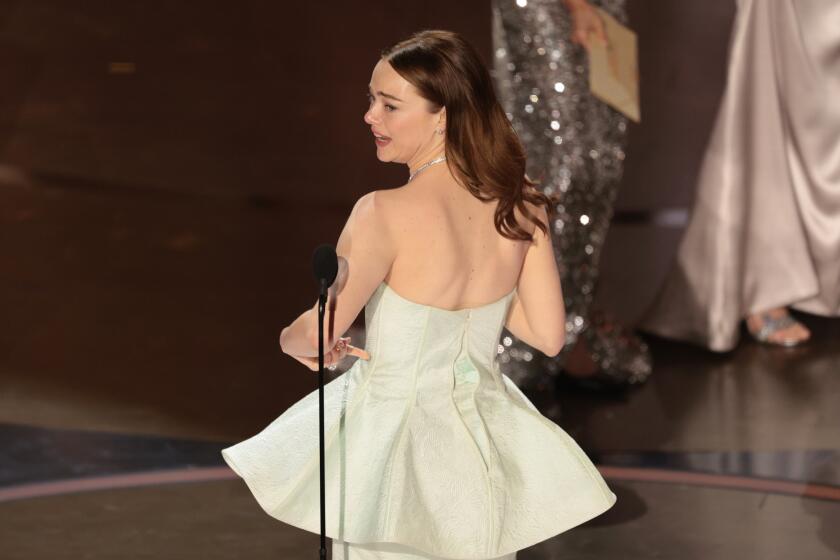Column: When picking an Oscars best picture, shouldn’t you vote for one you’d watch again?

As with Congress, we know the Academy Awards to be an important and quintessentially American institution because everyone loves to complain about how absurd, ineffectual and meaningless it is until any type of change is suggested or, God forbid, implemented.
Then the outrage rises to volumes loud enough to be heard at the rebel base on red-velvet-cake planet Crait.
No doubt the entire “Star Wars” universe reverberated with the displeasure voiced over the film academy’s proposal last year to introduce a new category for outstanding achievement in popular film. WWWHHHHAAAATTTT??? came the collective roar.
Was the academy trying to dumb down the Oscars? Ghettoize films like “Black Panther” and “A Star Is Born”? Or, merciful heavens, make the telecast even longer?
Ironically, some of those roaring were the same folks who regularly whine about the cinephile-elitism of the best picture nominees, which, they say, is the reason for the telecast’s ever-declining ratings.
Why would people spend three hours watching a show about films most have never seen?
Still, with Olympics-worthy backpedaling, the academy quickly made it clear that this new popular category would not be in place for this year’s award. As if in relief, voting members produced one of the most diverse nominee lists in recent history. “BlacKkKlansman” marks the first time a Spike Lee film is in contention for best picture, and “Roma” is the first Neflix film to make the cut.
2019 Oscar roundtables: Watch every single video interview »
More important, although voters couldn’t quite bring themselves to lift the astonishing “Spiderman: Into the Spider-Verse” out of the animated film category, they did include the global blockbuster “Black Panther” and other box-office bonanzas — “A Star Is Born” and “Bohemian Rhapsody”—alongside the type of small but critically acclaimed films that have, in recent years, dominated the category.
In other words, exactly the kind of list the academy had in mind when it doubled the number of potential best picture nominees in 2011 after “The Dark Knight” was shut out of the top race because, well, it was about Batman.
Which film wins is another story.
As it has been for years, the winner will be chosen by a preferential ballot. This process is only slightly less confusing and counterintuitive than the electoral college; in both cases, it is possible that the nominee ranked No. 1 by the most people will not actually win the race.
Process aside, the real competition is not about which film voters consider “best” but which definition of “best” they are using. Best in terms of craftsmanship or story? In perfectly showcasing the power of film or pushing its boundaries? In impressing audiences or the film community?
As recently as the late ’90s, most best pictures were also very popular films, but in the new millennium, that began to change. As the midlevel movie moved toward extinction, film increasingly came in two sizes: art house and franchise.
The last smash hit to win that title was “The Lord of the Rings: Return of the King” and it’s hard not to feel like academy voters have spent the past 15 years trying to make up for it in some way. In recent years, it’s a rare nominee list that includes more than one big box-office hit.
It is the film community not the hoi polloi that is voting after all, and smaller films need to be supported to ensure they continue to be made. Big hits are not always excellent films.
But sometimes they are. And we shouldn’t hate them because they’re popular.
I am not a member of the film academy but I watch A LOT of movies, and the ones I consider best are the ones I watch multiple times.
Which seems like a simple enough rule when it comes to voting for best picture: Would you, for reasons other than professional requirements, watch this movie more than once?
I’m not talking about repeat viewings of convenience, like you happen to be watching TNT’s “Oscar winners” week while you’re trying to catch up on the ironing, or a friend has never seen, say, “Argo” and so rather than fight about it, you just go along.
No, it must be a repeat viewing of intent, one that requires going to the trouble to buy it, rent it or seek it out on a streaming service just because you want to see it again.
Because if a movie is really the best of this year, it should be good next year and the year after that.
If a movie is really the best of this year, it should be good next year and the year after that.
So, show of hands (and be honest now), how many of us who are not film critics have sat through repeat performances of “Birdman”? Or “The Artist”? Or “The Departed”? “Slumdog Millionaire,” OK; “Crash,” not even on an airplane. “Argo”? See above. “The Silence of the Lambs,” oh yeah; “The Last Emperor,” maybe; “Dances With Wolves”? Hahahahaha.
I realize this is a very subjective test — I watch “Return of the King” each and every year and most non-Tolkien-obsessed people probably do not — and not a perfect system by which to judge past winners. Many factors outside cinematic excellence contribute to a film’s longevity. While I don’t think “American Beauty” had been topping anyone’s queue lately (sorry Allison Janney; you were amazing), the accusations made against Kevin Spacey have probably removed it from the rotation altogether.
The pain and power of some films — “12 Years a Slave,” “Schindler’s List” — make them difficult to watch again, while our expanding cultural consciousness make others, like “Driving Miss Daisy” or “Gone With the Wind” painful in different ways.
But still I think it is a worthwhile question for those voters sifting through their screeners or reclining in a free screening. (Actually, the first question might be: Would I pay to see this movie? Even if, as in the case of “Roma,” it is already available on Netflix.)
I, for example, have already seen “Black Panther” and “BlacKkKlansman” three times each, so they would top my best picture list, not that anyone is asking.
Certainly, one of the purposes of the Oscars is to alert the public to films that they otherwise might not see, and for the film community to honor rewarding films it believes are contributing to the art form. But while the word “outstanding” is very elastic, it doesn’t mean “groundbreaking film that most people won’t enjoy enough to ever watch again.”
So maybe instead of a separate best picture Oscar for “popular” films, we need one for those types of movies. I’ll leave it to the academy to come up with a better name.
More to Read
The biggest entertainment stories
Get our big stories about Hollywood, film, television, music, arts, culture and more right in your inbox as soon as they publish.
You may occasionally receive promotional content from the Los Angeles Times.







